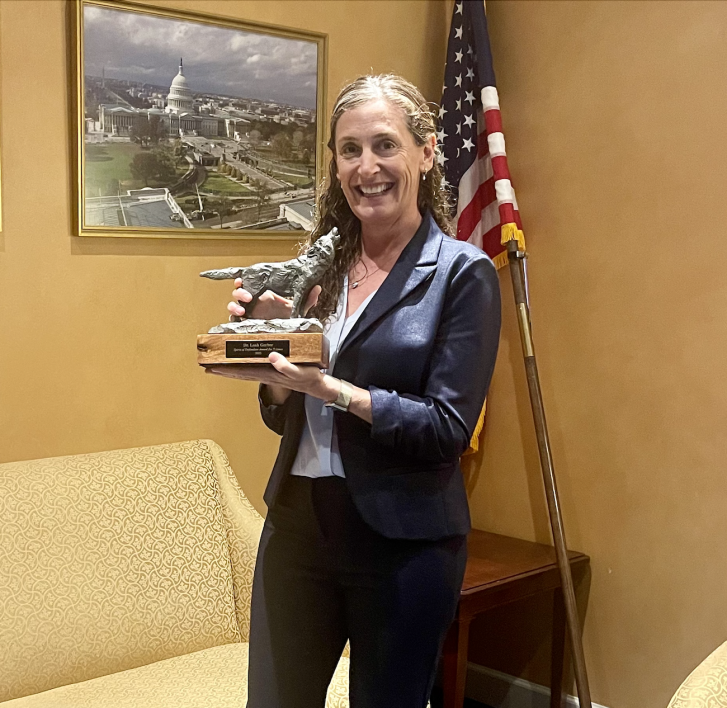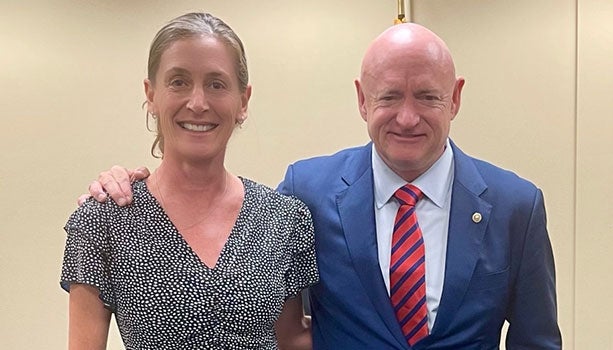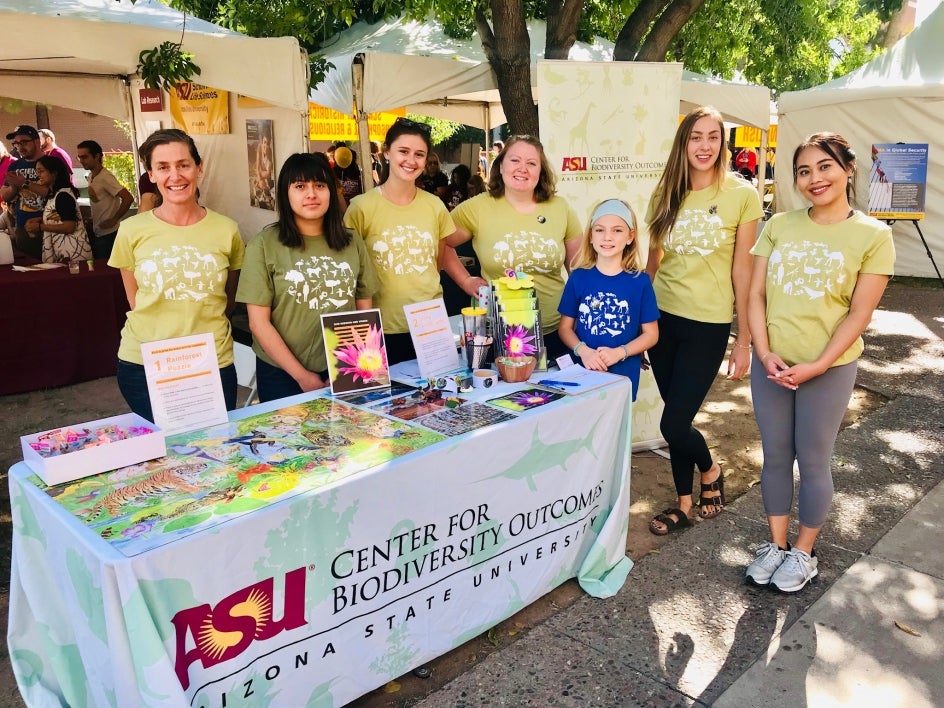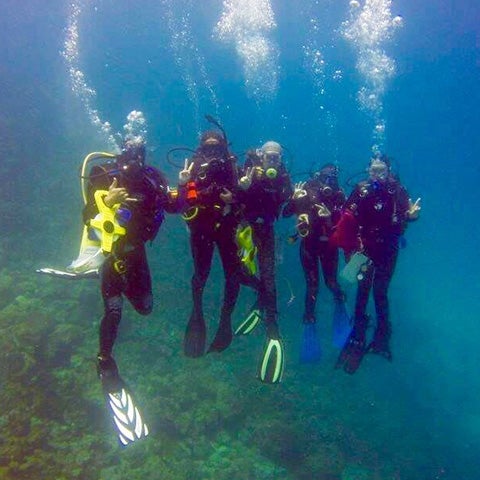To save biodiversity, it’s time to turn science into societal outcomes

ASU Professor Leah Gerber’s research, teaching and leadership advance the integration of science in decision processes to achieve sustainable biodiversity outcomes. Courtesy photo
For decades, scientists have held data about Earth’s biodiversity in hand — a crisis replete with 1 million species facing extinction, more so than at any other time in human existence — and yet, collectively, our global actions to protect species have, for the most part, been a failure.
In 2021 alone, 23 species were taken off the endangered species list because they had gone extinct.
“There is no repairing extinction,” said Arizona State University Professor Leah Gerber in a recent article published in Conservation Biology and co-authored by ASU colleagues Chris Barton and Derrick Anderson. “But averting biodiversity loss is a new type of problem. Without public investment in both the production of science and its use — and an explicit effort to integrate the two — we will continue to suffer the irreversible consequences of biodiversity loss.”
Gerber and co-authors point out that the rate of extinction is 1,000 times greater than the estimated background species extinction rate, or what would occur in the wild without negative human impacts. According to the Intergovernmental Science-Policy Platform on Biodiversity and Ecosystem Services (IPBES) report, for which Gerber was a lead author, currently 25%, or 1 million species, are threatened with extinction.
And it’s not just charismatic animals forever lost. This past scorcher of a summer, the world’s hottest on record, had a statewide impact when even the mighty saguaro, the sentinels of the Arizona desert, seemingly flailed their arms and fell, dying in unprecedented numbers due to extreme heat and drought.
Perhaps it’s finally time when enough people will begin take notice and do something different to protect biodiversity.
Addressing the biodiversity crisis has been the laser focus of ASU’s Global Futures Lab, a medical center focused on the health of the Earth. There, one of the world’s leading conservation scientists, Gerber, has been increasingly using her expertise in evidence-based decision-making to address biodiversity challenges by bringing innovative ideas and lessons learned to the community, state, and national and global stage.
Having spent most of her career producing science with the assumption that good science is needed for conservation decision-making, she has come to realize that without action, science biodiversity data will continue to wither on the policymaking vine.
“Thirty years later, I now realize that the trifecta of science, education and policy provide a synergistic pathway for impact,” wrote Gerber in a perspective piece published in the prestigious journal Nature Water. Gerber is a member of the Global Futures Lab, a professor of conservation science in ASU's School of Life Sciences and founding director of the Center for Biodiversity Outcomes at ASU. Gerber’s research, teaching and leadership advance the integration of science in decision processes to achieve sustainable biodiversity outcomes.
An academic’s journey from science to policy
Defenders of Wildlife recently awarded ASU Professor Leah Gerber, one of the world’s leading conservation scientists, with its Spirit of Defenders Award for science. Courtesy photo
Gerber’s role as a biodiversity advocate has taken her on an academic journey from the San Francisco Bay Area to the Pacific Northwest to the Sonoran Desert. A sampling of her fieldwork includes research on marine mammal behavior and demography in Mexico, Panama and Alaska, plastic pollution mitigation in Hawaii, addressing deforestation in Colombia, Ecuador and Peru, marine reserves and ecotourism issues in Baja California and the Galapagos Islands, and biodiversity planning in Vietnam and Myanmar.
Her pioneering work to bring return-on-investment approaches to democratize the use of data in decision-making has placed Gerber on the national and international stage.
Recently, to mark the 50th anniversary of the Endangered Species Act (ESA), Gerber mingled with citizen scientists, the public, policymakers and nongovernmental organizations (NGOs) in Washington, D.C., as part of an ASU delegation to reflect and celebrate on the act, including a meeting with Arizona Sen. Mark Kelly and others.
There, Gerber was honored by the D.C.-based conservation group Defenders of Wildlife, which awarded Gerber with its Spirit of Defenders Award for science.
“We are delighted to present Dr. Gerber this award for her tireless work advocating for the relevance of science in environmental policy and wildlife conservation, and for truly making a difference for species,” said Jamie Rappaport Clark, president and CEO of Defenders of Wildlife.
Next year, Gerber’s team will be representing ASU at the World Biodiversity Forum in Davos, Switzerland.
Communication is key
Between science and action, Gerber’s team realizes there is still a significant knowledge gap yet to overcome. “A healthy environment with rich biodiversity is inextricably linked to strong social and economic systems,” they write in the Conservation Biology article. “Yet, biodiversity is being lost at an alarming pace.”
“Only by actively linking research and action — and supporting both — can the irreversible public value failure that is extinction be avoided,” continues the article, which resulted from support from two recent NSF grants centered on the theme "actionable science in biodiversity conservation."
Gerber met with Arizona Sen. Mark Kelly on the 50th Anniversary of the Endangered Species Act in Washington, D.C. Courtesy photo
To do so, Gerber understands that “one recurring issue is communication.” Scientists, especially early-career scholars just starting their tenure-track positions, are driven by academic pressures to "publish or perish" and garner lucrative grant awards. She refers to this as the "loading dock model" issue.
“I used to think that producing quality research and publishing in reputable journals represented a clear pathway to impact for a scientist,” Gerber said. “Hundreds of publications later, I now consider this loading dock model to be entirely wrong.”
Gerber said that from her perspective, creating change began with a bit of navel-gazing and a willingness to change the ways scientists traditionally communicate — moving beyond the academy — to better engage policymakers.
“Despite the wealth of scientific knowledge available, policymakers often struggle to comprehend the intricacies of our research,” Gerber said. Often, scientists may use too much jargon from their fields, making the work unnecessarily harder to understand. “Bridging this gap requires honing my communication skills to distill complex scientific concepts into accessible language.”
And it requires reaching out from the ivory tower and engaging with citizens, policymakers and leaders.
“Presenting information in a way that resonates with policymakers, for example, by using real-world scenarios and relatable analogies is essential to fostering meaningful dialogues,” Gerber said.
“Clear, concise and accessible language can bridge the gap and help policymakers better understand the relevance and implications of scientific evidence. Seeking interactions, workshops and briefings with policymakers represents a promising pathway to bring scientific insights to decision-making.”
Gerber has also worked to ensure that the science projects she tackles are increasingly relevant to decision-making.
“To ensure that science is relevant to decision-making, I have learned that 'engaged science' requires close communication with policymakers and stakeholders throughout the research process, and a willingness to change the focus of a research project in response to feedback.”
Following what the science says
Enacted in 1973, the ESA remains the most important U.S. legislative act to protect biodiversity.
“I witnessed firsthand the power of science when a conservation policy I advocated for, based on research showing the relative extinction risk among species, was successfully implemented,” Gerber wrote.
Early in her career, Gerber was funded by the National Oceanographic and Atmospheric Administration (NOAA) to help develop some of the very first quantitative criteria for assessing risk of extinction in order to classify species under the ESA — based not on the charisma of critters or on advocacy group efforts, but on data.
“Federal agencies responsible for implementing the Endangered Species Act don't have enough resources to do everything for all species,” Gerber said. “As a result, agencies are regularly sued by conservation activist groups lobbying for particular taxonomic groups that are most favored — typically including the most charismatic species. By being forced to respond to lawsuits, agency scientists are waylaid from employing a strategic approach based on the best available science.”
ASU Professor Leah Gerber collecting data on humpback whale population biology in the North Pacific. Courtesy photo
Gerber’s team, for the first time, measured the actual species numbers to develop policy solutions. “By analyzing data on extinction risk for endangered species, we developed a metric that reflects the risk of extinction that could be used to inform decision-making. This analysis had an immediate impact on listing decisions for marine mammals,” Gerber said.
“You know, everyone loves whales,” she added. “And yet, our analyses suggested that many stocks had recovered from exploitation during whaling eras and were no longer endangered.”
As a result, both gray and humpback whales in the North Pacific were downlisted.
“There's a hesitation to downlist species from endangered to threatened because we like them and want them to remain protected. But the point of much of my work is that, for the Endangered Species Act to be successful, we need to properly implement it. This means downlisting species when data suggest recovery," Gerber said.
“My work on whale risk assessment is interesting because it's not like the results led to more protection; they led to more equitable science-based decision-making. Downlisting whales means we were able to disperse sparse resources to protection of endangered species in a way that maximizes potential outcomes for all species.”
It’s an ethos she has kept consistent throughout her career and passed down to her students, who will become the next generation of thought leaders.
“As long as we are not fully funding required actions to protect biodiversity, we will be implicitly making decisions about which species to prioritize. We're just not being transparent about what the choices are,” Gerber said.
Mainstreaming biodiversity science to solutions
For the past decade, as founding director of ASU’s Center for Biodiversity and Outcomes, Gerber has made it her scientific mission to enable discoveries and solutions needed to sustain Earth’s biodiversity in a time of rapid biophysical, institutional and cultural change.
“Most recently, I have shifted my scientific research to identify what determines impact, which necessarily involves understanding what kind of science policymakers need,” Gerber said. “While science generates evidence, policy provides the necessary framework to translate that knowledge into tangible actions.”
Turning biodiversity science into solutions has required a big rethink.
“Ten years ago, when I started our center, it was largely recognizing, OK, I have 150 publications. We do it, we publish it. Someone will take it up and use it,” Gerber said.
“Now, I don't think that's how things work. And so, the scholarship that I do now takes an approach where we co-produce the science in a demand-driven way, and that involves a constant communication with who the audience is.”
ASU Professor Leah Gerber (far left), with staff, students and daughter Lilly (in blue shirt) at an outreach event. Courtesy photo
One example of a tool Gerber’s center developed is the Recovery Prioritization Explorer, which allows audiences to tweak impact funding levels, or policy inputs, for an adaptive learning environment to run scenarios for biodiversity outcomes.
Another tool is a species threat abatement and restoration (STAR) metric, which estimates potential "conservation gain" that could be achieved for species through action taken within a geographical area (site, landscape, corporate footprint and country).
By working with stakeholders, from the community to policymakers, decision tools that elucidate available data provide a promising pathway to bring science to decision-making to maximize conservation outcomes.
Here are some recommendations as part of a prescription to save biodiversity on our planet:
- Develop and implement a national biodiversity strategy to help provide the most "bang for the buck" for conservation actions (the U.S. needs a federal organizing agency for biodiversity akin to the funding and impact of the NIH for human health).
- Increase federal funding to fully implement the ESA ($76 billion a year is needed to protect global biodiversity — less than 0.01% of the annual GDP. Twenty percent of the needed $1.2 billion a year is allocated in the U.S.).
- Move toward real-time science and action based on citizen and policymaker feedback.
- Continuously measure impacts and potential solutions.
- Adopt best practices for individuals, organizations and actionable science outcomes.
World in motion
ASU Professoe Leah Gerber and her team conducting underwater research on climate change impacts on marine biodiversity in the Galapagos Islands. Courtesy photo
The data are clear: Climate change is here to stay, with record summer temperatures and drought already affecting global biodiversity, and a new mass extinction underway due to our ever-expanding human footprint.
Perhaps no area of science policy is more critical than governing the future health of our planet.
“Engaging in policy-oriented work can be both time-consuming and frustrating,” Gerber said. “Scientists face the inherent complexities of navigating the political landscape to translate scientific evidence, which often contains uncertainties, into concrete and actionable laws and regulations. As a result, while science can provide a solid foundation for good policy, it seldom dictates or defines policy outright.”
Perhaps also lost in the message is that what’s good for the health of the planet is good for us. And yet, the potential for nature to sustainably maintain human quality of life has declined in almost all measurable categories, from the soil quality for the foods we eat to the quality of air we breathe.
Everything is interconnected; the future of all life on Earth, including our own, is now dependent upon the decisions of communities, countries and worldwide coalitions to reverse the impact of climate change and biodiversity loss.
“Ultimately, working at the interface of science and policy has been extremely rewarding," Gerber said. “I have witnessed the transformative potential of science-informed policies on a broad scale.”
To maintain optimism and hope in facing seemingly intractable problems associated with climate change, biodiversity loss and the future of humanity, Gerber strives to create a spirit of hope in her community by embracing the practice of mindfulness.
“Many scientists have experienced grief, anxiety and despair as they face ongoing ecological challenges,” Gerber said. “Mindfulness offers a way to counteract the culture of conflict that persists in the scientific community.”
Gerber’s optimism is also fueled by the inspiring work of students contributing to ASU’s Conservation Innovation Lab. For example, as part of Gerber’s Lenfest Ocean Program project to create structures to bring data to decision-making in the Galapagos Islands, she met Paola Sangolqui, a Galapagos native, while doing fieldwork.
Exploring the Equadorian Amazon rainforest with daughters Lilly and Gabriella. Courtesy photo
“I immediately realized that Paola was a remarkably talented scientist and future leader in conserving her islands,” Gerber said. She recruited Sangolqui to come to ASU as a PhD Student in biology and society in the School of Life Sciences. Three years later, Sangolqui was recently invited by Lenfest to speak at the U.N. Ocean Decade Conference in Barcelona, Spain. Sangolqui will share her research focuses on the relationship between conservation and human well-being in marine and coastal habitats.
“Paola is an example of ASU’s many brilliant young scientists who inspire me every day. I am truly grateful to be part of this incredible team of collaborative, high-calibur, engaged and kind conservationists. Seeing my students thrive is one of my greatest sources of hope for the future. Of all of the things I’ve done, I am most proud of their successes,” Gerber said.
The scholars in the Conservation Innovation Lab are representative of countless scientists dedicating their lives to addressing issues of economic growth, agricultural production, water security, biodiversity conservation and other urgent societal and ecological challenges. Because of tireless worldwide efforts, the issues they champion have been codified into the U.N.’s Sustainable Development Goals (SDGs).
Yet the SDGs now require a steep uphill climb to be reached. With 35 out of the 44 targets assessed showing negative trends, it is unlikely they will all reach their goals by 2030. If the goalposts are moved to 2050, it may be too late to reverse the change.
But Gerber remains an optimist — a “nature positive.” She believes that it is still possible to halt and reverse ecological degradation and biodiversity loss so that humans can coexist in harmony with nature.
“The urgency of global issues such as climate change and biodiversity loss require cohesive efforts from both scientists and policymakers,” Gerber said. “By nurturing a culture of open dialogue, fostering effective communication and prioritizing evidence-based decision-making, we can effectively bridge the gap between science and policy, and begin to formalize models for truly engaged scholarship.”
More Science and technology

NASA launches space telescope to chart the sky and millions of galaxies
California’s Vandenberg Space Force Base was the site for Tuesday’s 8:10 p.m. launch of the NASA SPHEREx mission aboard a SpaceX…

ASU-led Southwest Sustainability Innovation Engine funds 8 promising tech startups
In the startup world, tech companies often fall victim to what’s known as the “valley of death” — the gap between technological…
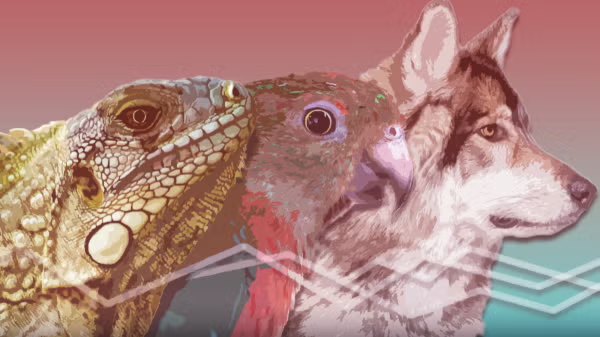
New study explores the link between diet, blood sugar and cancer risk across species
Researchers have long known that diet exerts a profound influence on health, including the risk of developing cancer. A new study…
